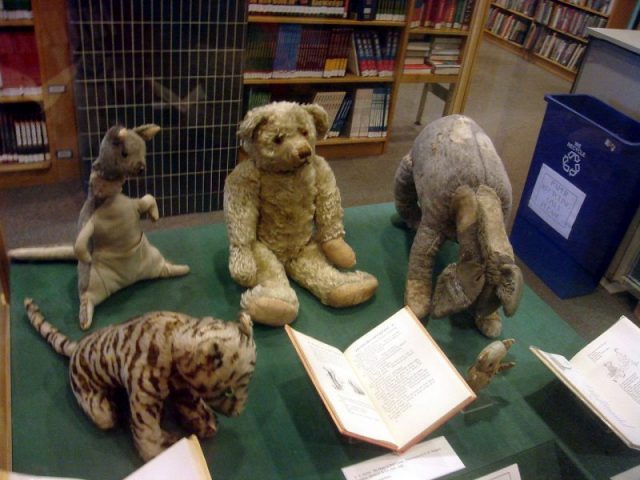Children and their grownups have been charmed for many years by sweetly bumbling Winnie-the-Pooh, along with his pals the anxious Piglet, doting Kanga and little Roo, hyper-happy Tigger, and depressive Eeyore. But both their author, A. A. Milne, and his immortalized son, Christopher Robin, came to resent their popularity.
Born in London in 1882, Alan Alexander Milne studied mathematics at Trinity College, Cambridge, where he wrote for the student publication Granta. His work caught the eye of editors of Punch magazine, which published his humorous essays and poems and hired him after graduation in 1903, where he became an assistant editor.
Milne married the socialite Dorothy de Selincourt, called Daphne, in 1913; their only child, Christopher Robin, was born in 1920.
During his lifetime, Milne wrote prodigiously. By the time of his death in 1956, he had published an autobiography, several anti-war polemics, seven novels, and nearly 40 screenplays and plays.
Despite that impressive output, Milne is best remembered today for two books of verse and two collections of stories about his son’s beloved stuffed teddy bear, Winnie-the-Pooh. And despite the fact that Winnie-the-Pooh and The House at Pooh Corner were both critical and commercial successes, neither father nor son were particularly pleased with the fame that the stories of the sweet bear brought them.

Papa Milne disliked being best known as a “children’s author.” Son Christopher Robin felt he couldn’t escape his fictional doppelganger’s celebrity. In the recent biopic Goodbye Christopher Robin, when his father defends his authorial choices by saying, “You asked me to write a book for you,” the son replies: “Yes, for me not about me!”
A. A. Milne had served as an officer of the army in World War I, when he was wounded in the Battle of Somme, one of the bloodiest battles in history. He came home with “shell shock,” or what today would be called Post-Traumatic Stress Disorder, and had a hard time resuming his previous life.
When Daphne gave birth to their only child in 1920, she and her husband had picked out a name for their hoped-for daughter: Rosemary. During his earliest years, the baby boy’s hair was kept long and he was dressed in girlish outfits. They called him Billy, but decided to christen the child Christopher Robin. His nickname morphed into Billy Moon when the toddler cutely mispronounced Milne.
In 1923, Vanity Fair published A. A. Milne’s most famous poem, the sentimental “Vespers,” which cruel classmates would later use to taunt the child: “Hush! Hush! Whisper who dares!/Christopher Robin is saying his prayers.” His first collection of children’s poems, When We Were Very Young, was published in 1924 and was illustrated by Milne’s friend E. H. Shepard, who would illustrate all the Pooh books.

The Milnes bought a country house, hoping that escaping London’s hubbub would be more conducive to A. A.’s writing. Walks in the nearby woods with his son, who brought along his stuffed teddy bear, inspired the first of the Pooh stories, featuring the Hundred Acre Wood and the game of Poohsticks.
Great Hollywood legends quotes
Winnie-the-Pooh and The House at Pooh Corner were immediately successful upon publication in 1926 and 1928.
Christopher Robin was sent to boarding school at age nine, where he was taunted, teased, and pushed down the stairs. By age 13, he’d taken up boxing to defend himself from the bullying. In his own 1974 autobiography, The Enchanted Place, published after his father’s death, Christopher Robin wrote that “Vespers” was the one work that over the years brought him “more toe-curling, fist-clenching, lip-biting embarrassment than any other.”

After A. A. Milne’s death in 1956, the rights to Winnie-the-Pooh were sold to Disney, which adapted them into highly successful movies and merchandise franchises.
The real Christopher Robin distanced himself from the fiction, the fortune, and his family. He served in World War II, but upon return, spoke infrequently with his father. He married his first cousin, Lesley de Selincourt, in 1948, which caused a rift with his mother. After his father died, he never spoke to his mother again.
The couple had one child, Clare, who suffered from severe cerebral palsy. They owned a bookshop in Dartmouth, where he tried to remain anonymous, though he would autograph books upon request.
Today, the actual stuffed Winnie-the-Pooh and his pals live behind glass in the children’s reading room at the New York Public Library.
